MISSOURI, USA — Missouri's wild turkey population has seen historic lows for several years.
The state's poult-to-hen ratio, or the number of young turkeys compared to adult female turkeys, reached an all-time high of 4.0 in 1971. That ratio has seen stark decreases in the decades since, according to the Missouri Department of Conservation (MDC) Wild Turkey Brood Survey.
Missouri has historically used this ratio to measure trends in the turkey population but has had difficulty comparing its numbers to other states. That's one of the major reasons the department broke with over 60 years of tradition and started using a new-standardized turkey count in 2024.
The annual brood survey in Missouri is largely compiled thanks to MDC staff and citizen volunteers recording turkey observations between June and August, but how those observations are recorded differs from scientific researchers and national standards. Missouri has essentially done things its own way since 1959, the department said.
"Production numbers you have seen in previous versions of this report can’t be compared between states. They are only good to show the trend in production in MO; that seems like a missed opportunity," Missouri's 2024 survey said.
To meet that opportunity, MDC started using a standardized counting method created by the National Wild Turkey Federation's Technical Committee. The new counting method won't replace the state's historical counting method, but would instead be included with it to bring its counting standards in line with national trends.
For example, researchers largely consider a 2.0 poult-to-hen ratio to be a good indicator of a healthy turkey population, MDC said in its 2024 brood survey. Missouri's historical method puts the state's ratio at 1.1 for 2024, however, the standardized method puts the ratio at 2.0.
"A few states like Missouri had been doing a brood survey for decades while others were just getting their brood survey off the ground," MDC said. "By standardizing the way data are collected and how they are censored between states, brood data can now be used to compare production across states."
For a list of specific ways the new statistical model differs from Missouri's historical model, click here to read this year's turkey survey.



